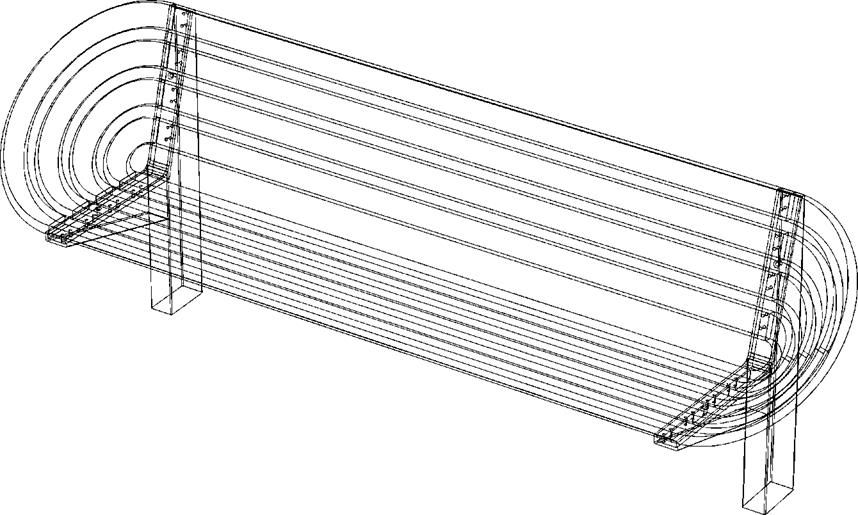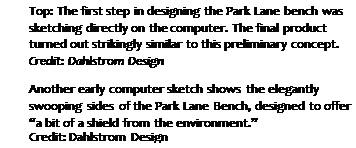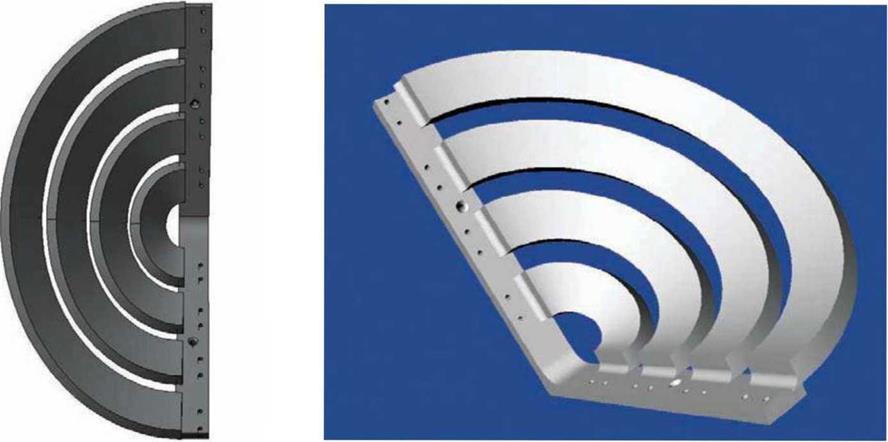have a lot of people who don’t know each other sharing a space
 and furniture in a museum or someplace. It’s like experimenting with what kind of a space you need for when you sit next to people you don’t know.”
and furniture in a museum or someplace. It’s like experimenting with what kind of a space you need for when you sit next to people you don’t know.”
When he began to design the Park Lane Bench for Nola, Dahlstrom turned his attention from interior public spaces to the world outside. “I thought of the bench as sort of an island in a park or the city environment. Instead of creating wooden armrests at the end of the bench, I wanted to do something that made a gesture outwards. It gives you a little bit of space to put your bag down but also to shield you from the environment.” Dahlstrom began his sketching directly in the computer, creating strong horizontal lines that swooped around at either end, almost like a running track. The strength of the gesture reflects Dahlstrom’s early career in design. “Many of my works start with some kind of graphic idea. I started out as a graphic designer, so it’s very important for me to make communicative and quite strong graphic pieces.”
One of the Park Lane’s unique features is an elegant combination of wood and metal. While this contrast creates visual interest, it was also done in response to pragmatic concerns. “Sweden is quite a cold country,” Dahlstrom points out, “and doing something from pure aluminum is not practical; it’s too cold to sit down. You need the wood to have a nice material to rest against. The aluminum was good to use for the bent part. It’s quite a harsh environment, so if you used bent wood for the outer part, it would get destroyed by the weather. You have too much stress built into the wood material, and sooner or later it would pop out.” The two elements also add to the graphic statement that is so important to Dahlstrom: “I like that when you follow one of those boards, you have wood, and then it translates into aluminum and then it’s wood again. Then, when you see the bench from behind, in a backlight, it’s like a silhouette. It’s all black, and you don’t see the change so it becomes even more of a graphic image.”
While the shape of the final bench is stunningly close to Dahlstrom’s original computer sketches, there were a few design and production details to be sorted out when the piece was considered full scale. “We did have to do some tests to try the seat angles and such,” Dahlstrom says, “and we had to change some things to get it comfortable from the angle of the seat to the back, and the angle of the seat itself.” Then came the more challenging part. “When that was finished and we were happy with the comfort, we did the geometry for the aluminum parts, and that was actually quite tricky,” he recalls. “This is quite a big aluminum piece. Of course, also the mold is quite big and costly, so we had to really think in a good way to make it not so costly. What we did was make the aluminum part the same, just turn it 180 degrees. So


 there are four different curves and each piece looks exactly the same from both sides,” he explains. “Every mold has two halves, and then you have these very tricky parting lines, and you have to have them in just the right spot to get them to separate. My studio did it together with Nola. They have great experts as they do quite a lot of aluminum casting.”
there are four different curves and each piece looks exactly the same from both sides,” he explains. “Every mold has two halves, and then you have these very tricky parting lines, and you have to have them in just the right spot to get them to separate. My studio did it together with Nola. They have great experts as they do quite a lot of aluminum casting.”
The back supports and feet are made of a single beam of steel that can be anchored to the ground in a park and has been given a surface treatment so it will look similar to the aluminum. Dahlstrom chose to have two rather than four legs. “I wanted it to be a little bit floating,” he says. “The leg goes from the back straight down, so the seat is floating, which gives it quite a nice silhouette,” he notes.
The seat and back will be available in a variety of wood, according to client requests. In addition, Dahlstrom notes that in Stockholm, park benches are traditionally dark green: “They are quite nice and we just did some computer sketches that show what the Park Lane would look like if you painted the whole thing green,
 |
 |
©Top: A screen grab from the 3D modeling program shows the beginning of the structural details, such as the angle of the seat and relation of the seat to the back. Two steel supports create legs that can be anchored to the ground, and yet give the bench a feeling of floating above the earth. Credit: Dahlstrom Design
® Above left: The curving end pieces were made of cast aluminum to provide strength in weather extremes. Each end piece of four curves is a mirror image of the other, allowing them to use one mold for both. Credit: Dahlstrom Design
® Technical, three-dimensional drawings, created by Dahlstrom Design and the manufacturer, Nola, are used to get every detail exactly right so there are no mistakes when making the very-expensive molds. Credit: Dahlstrom Design
even the aluminum.” The wood and metal parts are invisibly attached to one another with screws in the backside. “There are a series of holes in the aluminum, and there is an overlap on the wood. So on the side you’re sitting or resting your back on, you don’t see any screws,” Dahlstrom points out. “You screw it all together, then you put it onto the leg structure, so all the screws holding the wood are not visible because they’re inside the leg structure.”
 |
One of the things Dahlstrom finds most pleasing about the final product is that its form creates a strong—and changing—graphic image from all angles. Dahlstrom’s first foray taking what he learned from graphics into three dimensions happened with a toy. “I’ve always been interested in furniture design,” he says. “I had the opportunity to do this by doing wooden toys. I did a rocking toy built on flat pieces of wood that people put together themselves. The flat pieces were exactly what I wanted to see about translating my graphic design into 3D products. I could work flat and have it put together in a kind of sculptural way. Since I was interested in furniture,” he continues, “I started to do things for my own sake, like furniture for my own studio.” In 1993, he exhibited a small collection at the Stockholm Furniture Fair, and the next year went to the Milan Furniture Fair. Now, graphic design makes up only a small percentage of his work, while the majority is in product, furniture, and industrial design. “I’m really happy with what I’m doing,” Dahlstrom says. “When you do ordinary graphic design, it’s on a flat paper, and you have a fixed view on things; it’s supposed to be looked at 90 degrees to the paper. But in the case of furniture, as you move around the object, you see different patterns and details, and to me it’s more exciting.”



